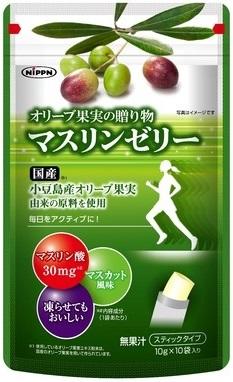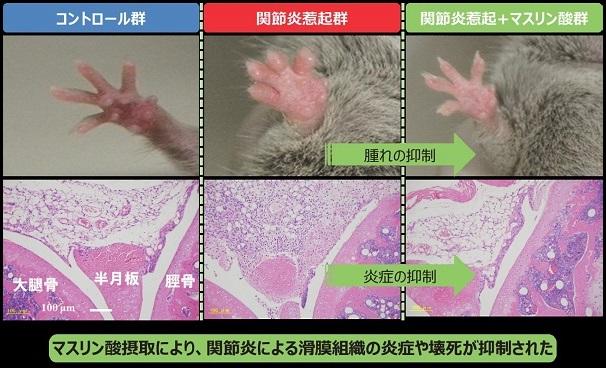Outcome Example of Bio-oriented Technology Research Advancement Institution
Issued on October 1, 2020



Accepted as "Foods with Functional Claims" for its effectiveness in maintaining skeletal muscle
With the advent of a super-aging society, locomotive syndrome ("Locomo" for short) has become a major issue for the elderly who require nursing care because of disorders of their motor organs such as knees and arms. The pain in the joint and muscle weakness will lead to the Locomo. Research from the University of Hyogo and NIPPN corporation revealed that maslinic acid in olive fruits may improve the joint's pain and promote an increase in skeletal muscle mass along with light to moderate exercise. Supplement products containing maslinic acid were accepted by the Consumer Affairs Agency as "Foods with Functional Claims." The manufacturers of these supplements are allowed to indicate a level of health benefits based on the acquired scientific evidence after obtaining their notification number.
Pain in the knee joint improved and muscle mass increased
|
For elderly persons to maintain the normal physical motor (locomotive) function, they are required to move the joints smoothly with no pain and maintain an adequate level of skeletal muscle mass. Moreover, because elderly persons tend to develop symptoms such as pain in the joint, it is an essential point of how to control inflammation that may induce this symptom. Dr. Nagai, a professor at the School of Human Science and Environment, the University of Hyogo and colleagues focused on the high inflammation suppressive effect of maslinic acid in animal joint tissues, which was already reported and conducted research of the impact of maslinic acid contained in olive fruits (Image 1) on the improvement of physical motor function. Thirty-six elderly persons aged 65 and over living in Hyogo prefecture were randomly allocated to two groups. The jelly packed in a laminate tube containing 60 mg of maslinic acid was given to one group's 17 participants. The jerry packed in the same type of laminate tube with no maslinic acid with the same appearance as that with maslinic acid was given to 19 of another group. The participants were asked to ingest the jelly every day for 12 weeks. Both groups were asked to visit a health promotion class once a week to do moderate to intense exercises, such as stretch and muscle training (resistance exercise), for 90 min and light to moderate exercise at home. |
 |
As a result, the knee pain score did not decrease with no change in skeletal muscle mass in the group with no maslinic acid. However, the pain decreased by about 10% with a several % increases in skeletal muscle mass of the trunk and arms in the group with maslinic acid. Moreover, although no difference in walking speed and muscle length in the feet was observed between the groups, there was a statistically significant increase in dominant handgrip strength in the group with maslinic acid.
Dr. Nagai explained the significance of their research results as follows: "For elderly persons to increase the skeletal muscle mass, it is usually required that they do intense exercise at a high frequency. However, if they take maslinic acid in combination with light to moderate exercise, their muscle mass would increase, resulting in the maintenance or improvement of physical motor function. Thus, it is suggested that intake of maslinic acid in combination with exercise may provide an effective measure for preventing the condition of need for long-term care."
Extract from olive pomace
More than 90% or more of Japan's olive oil is produced in Shodoshima (Kagawa prefecture) in the Seto Inland Sea. The pomace generated during the production process contains up to 0.4% of maslinic acid. NIPPN corporation developed a method of extracting and purifying maslinic acid and successfully produced olive fruit maslinic acid product containing 10% of maslinic acid.
When administering the olive fruit extract to arthritis model mice, mice with artificially induced arthritis, the arthritis preventive effects, such as relieving swelling of the forefeet of the mice, was observed in the group with the extract, but not in the group with no extract (control group) (Fig. 1). The results obtained from this experiment support the anti-arthritis effect of the extract on humans.

(Presented by NIPPN corporation)
It is expected that the development of new products using olive fruit pomace and a series of research on the health benefits of maslinic acid contribute not only to the revitalization of the local agricultural industry but also to the prevention of Locomo in the super-aging society and the extension of healthy life expectancy.
What is maslinic acid?
Though it is unfamiliar to the general public, maslinic acid is a natural substance called triterpene. It is one of the oil components generated in animals and plants. Maslinic acid protects fruits from microorganisms. It has been reported that maslinic acid has a wide variety of biological effects such as anti-inflammatory and anti-oxidant effects.
Project name
Strategic Innovation Creative Program (SIP) "Next-generation agricultural and fishery innovative technology"
Project period
FY 2014 to 2018
Title
Creation of a new next-generation functional food product promoting the maintenance of motor and physical functions
Project research institutes
The University of Hyogo, NIPPN corporation, and others
